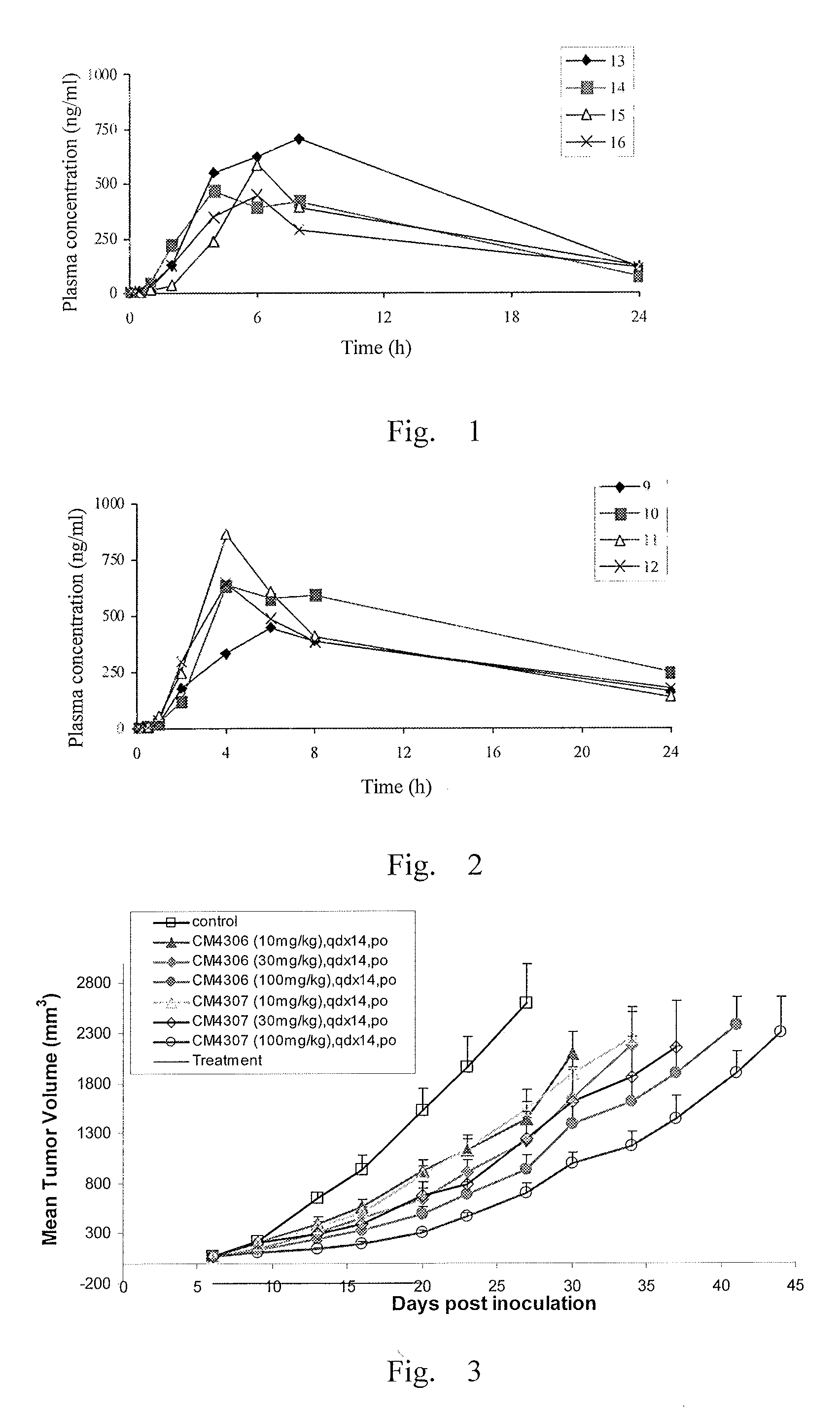Deuterium-substituted omega-diphenylurea and derivatives thereof and pharmaceutical compositions comprising the compounds
a technology of omega-diphenylurea and deuterium-substituted omega-diphenylurea, which is applied in the direction of drug compositions, immunological disorders, biocide, etc., can solve the problems of hypertension, weight loss, and side effects of sorafenib, and achieve better pharmacodynamic properties
- Summary
- Abstract
- Description
- Claims
- Application Information
AI Technical Summary
Benefits of technology
Problems solved by technology
Method used
Image
Examples
example 1
Preparation of N-(4-ehloro-3-(trifluoromethyl)phenyl)-N′-(4-(2-(N-(methyl-d3)aminoformyl)-4-pyridyloxy)phenyl)urea (Compound CM4307)
[0120]
[0121]1. Preparation of 4-chloropyridine-2-(N-(methyl-d3))carboxamide (3)
[0122]Into a 250 mL single-neck round-bottom flask equipped with waste gas treatment equipments, thionyl chloride (60 mL) was added. Anhydrous DMF (2 mL) was dropwise added slowly while keeping temperature at 4050° C. After addition, the mixture was stirred for 10 min, and then nicotinic acid (20 g, 162.6 mmol) was added in portions in 20 min. The color of the solution gradually changed from green into light purple. The reaction mixture was heated to 72° C., and refluxed for 16 hours with agitation. A great amount of solid precipitate formed. The mixture was cooled to room temperature, diluted with toluene (100 mL) and concentrated to almost dry. The residue was diluted with toluene again and concentrated to dry. The residue was filtered and washed with toluene to give 4-chlo...
example 2
Preparation of 4-chloropyridine-(N-(methyl-d3))-2-carboxamide (3)
[0131]
[0132]a) To a solution of phthalimide (14.7 g, 0.1 mol), deuterated methanol (3.78 g, 0.105 mol, 1.05 eq) and triphenylphosphine (28.8 g, 0.11 mol, 1.1 eq) in anhydrous tetrahydrofuran, a solution of DEAD (1.1 eq) in tetrahydrofuran was dropwise added under ice-bath condition. After addition, the mixture was stirred for 1 hour at room temperature. The mixture was purified by chromatography column, or the solvent in the mixture was removed, and then to the residue was added an appropriate amount of DCM and cooled in the refrigerator to precipitate the solid. The mixture was filtered and the filtrate was concentrated by rotary evaporator, and then the residue was purified by flash chromatography column to afford the pure product of 2-(N-(methyl-d3))-isoindole-1,3-dione (14.8 g, 90% yield).
[0133]b) 2-(N-(methyl-d3))-isoindole-1,3-dione (12.5 g, 0.077 mol) was dissolved in suitable amount of hydrochloric acid (6 N, 5...
example 3
Preparation of N-(4-ehloro-3-(trifluoromethyl)phenyl)-N′-(4-(2-(N-(methyl-d2)aminoformyl)-4-pyridyloxy)phenyl)urea
[0134]
[0135]The title compound was prepared according to the method of Example 1, except that CD3NH2 was replaced by CD2HNH2.
PUM
| Property | Measurement | Unit |
|---|---|---|
| temperature | aaaaa | aaaaa |
| temperature | aaaaa | aaaaa |
| temperature | aaaaa | aaaaa |
Abstract
Description
Claims
Application Information
 Login to View More
Login to View More - R&D
- Intellectual Property
- Life Sciences
- Materials
- Tech Scout
- Unparalleled Data Quality
- Higher Quality Content
- 60% Fewer Hallucinations
Browse by: Latest US Patents, China's latest patents, Technical Efficacy Thesaurus, Application Domain, Technology Topic, Popular Technical Reports.
© 2025 PatSnap. All rights reserved.Legal|Privacy policy|Modern Slavery Act Transparency Statement|Sitemap|About US| Contact US: help@patsnap.com



